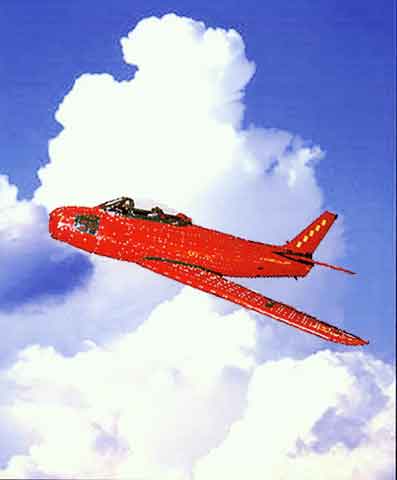 |
||
|
Flying view of Ken Senar's mecanno Sabre. Unfortunately the CAA would not give it a licence. Some more about Ken's meccano building exploits: There are no usable pictures of the Vampire yet, except one which shows that it only just fits in our study (should be a spare bedroom) to the point that when the wings are on Margaret can't sit at her desk and I have to crawl past underneath. At the end of this E-mail I shall include the formal write up which will appear at this year's Skegness exhibition, that way you'll be bang up to date without me writing it all again. "The Sabre took over 12 months actual work, sometimes as many as 30 hours in a week. Research was easy as I have a copy of 'Sabre Pilot's Notes' and plenty of very good usable pictures and scaleable drawings in Larry Milberry's book 'Canadair Sabre'. It got second prize at Skegness in 2000 (I think). As to the apparent double-curvature at the nose, etc., this was created by using small plates (rectangular and triangular) having single curvature only. I used judicious overlapping and clamping as well as through-bolting. It was the nose and nosewheel mechanism (turning as it retracted, steering, and springing) that was the first challenge. This done, my second challenge was the intake and nose as far back as the bottom of the windscreen. Then I added the nosewheel door and its mechanism. Everything at that stage was operated by winding the old fashioned (but still extremely useful) Meccano crank handles. I reckoned that having progressed to that stage any other problems - and there were many - could be solved as work progressed. You could see that the model was on a plinth with all control linkages starting from the remote stick and rudder pedals in the base. This meant that the plinth had to be removable and all electrics and rodding disconnectable. There is a piece of plinth (a stub) permanently attached to the belly. This slid into the main column and was secured by rods and collars. 8 of them and 16 collars. To get everything to line up I made a pair of very strong Meccano jacks so that the fuselage could be slowly lowered on to the plinth. These jacks were also used for assembling the rear fuselage section into place (it split as per prototype). Additional to this, the outer wings came off for transport, and with them the flaps and ailerons. It took about an hour and a half to assemble on site, and that was with Margaret reading out to me the sequences of assembly from a special model check list which I wrote to save my skin in the usual pre-exhibition chaos and mayhem. The Sabre appeared in the temporary exhibition gallery at the Museum of Liverpool Life in 2001. This exhibition was to celebrate the centenary of Frank Hornby's first Meccano patent. The model was in Liverpool for about 6 months and was then dismantled. All parts were returned to standard condition, repainted if necessary, and put away. But that is not all. The Meccano dragline excavator (as per the web site http://www.schraube-und-mutter.de/mmg/meetings/meeting20001007_2.html ) was built at the same time. I had built the same model, to a far less standard, some years previously, so this was a fully detailed rebuild which won me first prize at Skegness. This model weighed well over a hundredweight and also broke down into sections for transport, and had an erection manual. It was six feet high and over 13 feet long, walked under its own power, and carried out (from a remote control box) all the functions of the full size prototype which was at Corby before it was cut up. The same model was also exhibited and demonstrated working every 45 minutes at the Museum of Liverpool Life over a whole extended 'Families Weekend'. It never failed and was granted applause at the end of almost every demonstration - much to the surprise of the museum staff! The Butters dockyard crane (also on the web and at Skegness 2 years ago [second prize]) was radio controlled and stood over 11 feet high when the jib was fully luffed in. It, too, simulated all the functions of the full size one at Cammell Laird's dockyard in Birkenhead. Like the dragline, I built the model from scale drawings and photographs of the prototype. My next model, already half researched, will have to wait a while as I am too occupied at present to progress it, having been, last night, sworn in as a Churchwarden at Tattenhall Church. 48 hour days should be standard issue for retired people." (Thanks to Ken Senar.) |
||